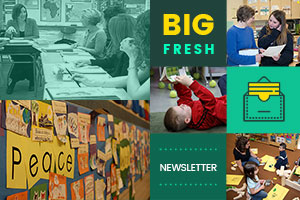Readers are plentiful; thinkers are rare.
Harriet Martineau
It was early in September, and Julie was leading her third graders in a discussion of a read aloud. She began, “Now let’s think about this character…”
A boy piped up immediately, “I don’t like thinking!”
Julie’s eyes widened, and she responded instantly, “But thinking is good for the soul!”
I’d been observing the class for almost an hour. There was no question it was a rambunctious group, but there was more to the tension I felt than excess energy. Julie was pushing and students were resisting, and in that moment I knew what the resistance was about.
Julie expects her students to think deeply about the books they are reading and the texts they are writing, and to share that thinking with classmates. In conferences and minilessons, Julie would ask thoughtful open-ended questions, and the students would give superficial answers, thrown back at her as quickly as possible. The need in that classroom wasn’t for learning—it was for unlearning. The kids wanted to “do school”—to rush through tasks and figure out how to please Julie with their responses. They couldn’t see yet that Julie’s pleasure would come from seeing them immersed in thinking hard and loving reflection.
When a student says, “I hate to think,” I wonder if it is equivalent to “I hate to write,” because they are viewing thinking as punishment. How many times have they heard, “You go sit in that chair over there and think about it”? When my daughter was in the primary grades and children misbehaved in her school, they were sent to the “Reflection Room” to contemplate the error of their ways. My husband and I laughed and said it sounded a lot better than detention, but do we want kids associating reflection with bad behavior? Or maybe some students view thinking as a losing game of trying to guess what’s in the teacher’s head, so the more quickly they throw out an answer, the more time they will have to come up with another answer. It’s a version of Beat the Clock being played out day after day in some classrooms, and you win by being done with the task.
Anyone who has experienced the joy of deep thinking and being immersed in a literacy activity (whether it’s reading a book, writing a narrative, or listening to a story) would argue that it’s good for the soul. Deep thinking provokes a happy tired feeling, like an energizing workout at the gym where you’ve pushed yourself, only you’ve built some new neuron paths instead of muscles. Julie and I chatted later about how she has her work cut out for her in helping students recognize this joy and where it can come from. But it’s also the most essential work that needs to be done in schools.
This week we look at favorite characters in children’s books, and how to use them in instruction. Plus more as always—enjoy!
Brenda Power
Founder, Choice Literacy
Free for All
[For sneak peeks at our upcoming features, quotes and extra links, follow Choice Literacy on Twitter: @ChoiceLiteracy or Facebook: http://www.facebook.com/ChoiceLiteracy or Pinterest: http://pinterest.com/choiceliteracy/]
Here are two features from the archives on instruction with beloved characters from children’s literature.
Franki Sibberson shares her Characters We Love booklist:
http://www.choiceliteracy.com/articles-detail-view.php?id=474
Ann Williams finds a creative way for students to empathize with characters in Yoga and Character Traits:
http://www.choiceliteracy.com/articles-detail-view.php?id=996
Ruth Shagoury and Meghan Rose at the LitforKids blog have posted a fun book flight on a favorite character type from children’s literature, Rapunzel and Other Maidens in Towers:
For Members Only
Shari Frost is alarmed when she realizes how rarely children of color are represented as main characters in book series. She decides to compile a list of Multicultural Series Books:
http://www.choiceliteracy.com/articles-detail-view.php?id=2034
Gigi McAllister shares how she combines vocabulary instruction with analysis of character traits in her fourth-grade classroom:
http://www.choiceliteracy.com/articles-detail-view.php?id=2121
Mary Helen Gensch explains how to find craft lessons in beloved children’s books. She uses a mentor text with an engaging main character to describe the process. This is the first installment in a three-part series:
http://www.choiceliteracy.com/articles-detail-view.php?id=2088
Jan Burkins and Kim Yaris continue their series on teaching mindfulness with Eight Picture Books That Show (vs. Tell) How to Be Mindful:
http://www.choiceliteracy.com/articles-detail-view.php?id=2112
In this week’s video, Katie DiCesare is conferring about characters in first grade:
http://www.choiceliteracy.com/articles-detail-view.php?id=1590
That’s all for this week!



